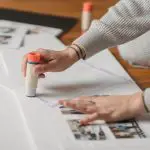Are you wondering if fabric glue is effective on velvet? Look no further! This article will provide you with all the information you need to know about using fabric glue on this luxurious fabric.
From understanding the nature of velvet fabric to the types of fabric glue available, we’ve got you covered. Follow our step-by-step guide and learn some tips for ensuring a strong bond.
Let’s dive in and discover if fabric glue truly works on velvet!
Table of Contents
Understanding Velvet Fabric
Velvet fabric is known for its luxurious feel and distinct pile texture. When it comes to caring for velvet fabric, there are a few important things to keep in mind.
First, velvet should be dry cleaned or spot cleaned rather than being washed in a machine. The delicate fibers of velvet can easily be damaged by the agitation and water involved in a typical washing machine cycle.
Additionally, velvet should be stored carefully to avoid crushing or flattening the pile. Hanging velvet garments on padded hangers or rolling velvet fabric for storage can help maintain its shape and texture.
In terms of its properties, velvet fabric is made from a variety of fibers, including silk, cotton, and synthetic materials. This variety in composition gives velvet its unique characteristics. Velvet is known for its softness, sheen, and rich, deep colors. The pile of velvet can vary in length, giving different types of velvet their own distinct look and feel. Additionally, velvet is known for its ability to absorb and reflect light, which contributes to its luxurious appearance.
Types of Fabric Glue Available
When it comes to fabric glue, you’ll find various types available for your needs. Whether you’re working with velvet fabric or any other type of fabric, it’s important to choose the right fabric glue to ensure a strong and durable bond.
There are different types of fabric glue that cater to different needs, such as washable fabric glue, permanent fabric glue, and no-sew fabric glue.
Washable fabric glue is ideal for projects that require frequent washing, such as clothing or accessories. It allows you to easily remove the glue when needed.
Permanent fabric glue, on the other hand, provides a strong bond that can withstand multiple washes. It’s perfect for projects that require a long-lasting bond, like upholstery or home decor.
No-sew fabric glue is a great option for those who don’t have access to a sewing machine or simply prefer not to sew. This type of glue is designed to create a strong bond without the need for stitching. It’s perfect for quick fixes or small projects.
When using fabric glue, it’s important to consider the drying time. Some glues dry quickly, while others may take longer to set. It’s crucial to follow the instructions provided by the manufacturer to ensure proper drying and bonding.
Factors to Consider Before Using Fabric Glue on Velvet
Before using fabric glue on velvet, there are two key points to consider: velvet compatibility with glue and glue application techniques.
Not all fabric glues are suitable for use on velvet, as the delicate nature of the fabric requires a specific type of glue that won’t damage or stain it.
Additionally, proper application techniques are crucial to ensure a strong bond without any visible glue residue.
Velvet Compatibility With Glue
Glue might not adhere well to velvet due to its smooth and slippery texture. When it comes to using fabric glue on velvet, it is important to consider the compatibility between the two materials.
Velvet is a luxurious fabric known for its softness and delicate appearance. However, this very quality that makes it so desirable also poses a challenge when it comes to bonding with glue. Velvet’s smooth surface makes it difficult for the adhesive to grip onto the fibers, resulting in poor adhesion.
Additionally, the slippery nature of velvet can cause the glue to slide off or not penetrate the fabric effectively. To ensure a strong bond, it is recommended to use a specialized velvet adhesive that is specifically designed to overcome these challenges and provide optimal glue strength on velvet fabric.
Glue Application Techniques
There are various techniques for applying adhesive to velvet fabric. When working with velvet, it’s important to choose the right glue and apply it correctly for optimal results.
One technique is to use a small brush or sponge to apply a thin layer of adhesive evenly onto the fabric. This helps to prevent any excess glue from seeping through the fibers and causing stains or discoloration.
Another technique is to use a fabric glue pen, which allows for more precision when applying the adhesive.
It’s important to allow the glue to dry completely before handling or moving the fabric to ensure a strong bond.
If any glue residue remains after drying, it can be gently removed using a cotton swab or a small amount of rubbing alcohol.
Step-by-Step Guide: Applying Fabric Glue on Velvet
To apply fabric glue on velvet, start by gently spreading a thin layer of the adhesive onto the fabric’s surface. When working with velvet, it’s important to be cautious and avoid using excessive amounts of glue, as it can seep through the fabric and leave visible marks. Allow the glue to dry for the recommended time, which is usually around 24 hours, but may vary depending on the brand and type of glue used. It’s crucial to follow the manufacturer’s instructions for the specific glue you’re using to ensure proper drying time.
When applying fabric glue on velvet, there are some common mistakes to avoid. One of the most common mistakes is using too much glue, which can cause the fabric to become stiff and lose its soft texture. Another mistake is not waiting for the glue to dry completely before handling or wearing the item. This can result in the glue not bonding properly and the fabric coming apart. It’s also important to apply the glue evenly and avoid any clumps or uneven layers, as this can affect the overall appearance and durability of the bond.
Tips for Ensuring a Strong Bond on Velvet
By following these tips, you can ensure a strong bond on velvet when applying fabric adhesive. Velvet can be a challenging fabric to work with due to its texture and pile, but with the right techniques, you can achieve excellent results.
Firstly, it is crucial to prepare the fabric before applying the adhesive. Gently brush the velvet to remove any loose fibers or dirt that may interfere with the bonding process. This step will help create a clean and smooth surface for the adhesive to adhere to.
Next, choose the appropriate bonding technique for your project. Depending on the type of fabric adhesive you are using, you may need to apply it directly to the fabric or spread it on both surfaces to be joined. Follow the instructions provided by the manufacturer to ensure proper application.
Once the adhesive is applied, press the fabric together firmly but gently. Avoid using excessive force, as this may damage the delicate fibers of the velvet. Allow the adhesive to dry for the recommended amount of time, which is typically 24 hours. Rushing the drying process can result in a weak bond.
Pros and Cons of Using Fabric Glue on Velvet
Using fabric adhesive on velvet has its advantages and disadvantages. Before deciding whether to use fabric glue on velvet, it is important to consider the pros and cons.
| Pros | Cons |
|---|---|
| Easy to use | Potential for visible glue marks |
| Provides a strong bond | Glue may seep into the fabric and stiffen it |
| Can be used to attach embellishments | Limited repositioning options |
One of the main advantages of using fabric glue on velvet is its ease of use. It eliminates the need for sewing and allows for quick and convenient application. Additionally, fabric glue provides a strong bond, ensuring that your velvet pieces stay securely in place. It can also be used to attach embellishments, such as beads or sequins, without the need for stitching.
However, there are some drawbacks to consider. One potential disadvantage is the possibility of visible glue marks on the velvet. This can be especially problematic if you are working with a delicate or light-colored fabric. Another concern is that the glue may seep into the fabric and stiffen it, altering its texture and drape. Additionally, once fabric glue is applied, it is difficult to reposition the pieces, so it is crucial to plan and position carefully before adhering.
Alternative Adhesive Options for Velvet
One option for attaching fabric pieces on velvet is adhesive tape, which offers a temporary bond and easy repositioning.
However, if you’re looking for alternative adhesive options for velvet, there are a few to consider.
One popular choice is fabric glue. It provides a permanent bond and can be used on a variety of fabrics, including velvet. When applying fabric glue on velvet, it’s important to use the right technique. Start by applying a thin layer of glue onto the fabric, avoiding excessive amounts that could seep through the fibers. Gently press the fabric onto the velvet, making sure to align the edges properly. Allow the glue to dry completely before handling the fabric.
Another alternative option is fusible web. This adhesive comes in sheets or rolls and is activated by heat. It works by melting the webbing between two layers of fabric, creating a strong bond. To use fusible web on velvet, place the webbing between the fabric layers and apply heat with an iron. Remember to follow the manufacturer’s instructions for best results.
Frequently Asked Questions About Using Fabric Glue on Velvet
Are you wondering if velvet fabric is suitable for your project?
Do you need to find the best fabric glue for working with velvet?
Are you looking for tips on how to apply fabric glue to velvet?
In this discussion, we will explore the suitability of velvet fabric, recommend the best fabric glue options, and provide application tips to help you achieve the best results with your velvet project.
Velvet Fabric Suitability?
Velvet fabric is often suitable for a wide range of projects. Its luxurious feel and rich look make it a popular choice for clothing, home decor, and upholstery. But when it comes to adhesive compatibility, not all glues are created equal. Before using fabric glue on velvet, it’s important to consider the properties of the fabric and the compatibility of the adhesive. Velvet is a delicate fabric with a high pile, which means it has a dense, soft surface. This can make it challenging for certain glues to adhere properly. It’s recommended to use a fabric glue specifically designed for velvet or a strong adhesive that is compatible with delicate fabrics. Always test a small, inconspicuous area first to ensure the glue doesn’t damage or discolor the fabric.
| Adhesive Type | Compatibility with Velvet | Strength |
|---|---|---|
| Fabric glue | High | Medium |
| Super glue | Low | High |
| Hot glue | Medium | High |
| E6000 | High | High |
Best Fabric Glue?
When choosing the right adhesive for your fabric projects, it’s important to consider factors such as compatibility, strength, and durability. Fabric glue is a popular choice for many crafters and sewers as it offers convenience and versatility.
Some of the best fabric glue brands on the market include Aleene’s Original, Beacon Fabri-Tac, and E6000 Craft Adhesive. These glues are known for their strong bonding capabilities and ability to work on a variety of fabrics, including velvet.
While fabric glue can be a great option for quick fixes and temporary projects, it is important to note that it may not provide the same level of durability as sewing. For more permanent and high-stress applications, sewing is still the preferred method.
However, fabric glue can be a valuable tool in your crafting arsenal, providing a quick and easy solution for smaller projects.
Application Tips for Velvet?
To achieve optimal results when working with velvet, it’s important to handle the fabric with care and avoid excessive stretching or pulling. Velvet is a delicate fabric that requires special attention. When sewing with velvet, it is recommended to use a sharp needle and a fine thread to prevent any damage to the fabric. Additionally, using pins sparingly and placing them within the seam allowances can help avoid visible holes or marks on the velvet. Another useful technique is to use a walking foot or a roller foot when sewing velvet to prevent the fabric from shifting or puckering during the stitching process. By following these velvet care tips and sewing techniques, you can ensure that your velvet projects turn out beautifully.
| Velvet Care Tips | Velvet Sewing Techniques |
|---|---|
| Handle with care | Use a sharp needle |
| Avoid stretching | Use a fine thread |
| Use pins sparingly | Use a walking foot |
Conclusion
In conclusion, fabric glue can be a useful tool when working with velvet fabric. However, it is important to carefully consider factors such as the type of fabric glue, the condition of the velvet, and the desired outcome before applying it.
By following the step-by-step guide and using the tips provided, you can ensure a strong bond between the fabric and the glue. Keep in mind that there are alternative adhesive options available if fabric glue does not meet your needs.
Happy crafting!
- Is the Google Pixel 3 Fabric Case Still a Good Choice Today? A Retro Review - June 25, 2025
- The Best Fabric Pencil Cases for School, Art, and Work - June 25, 2025
- Where Can You Find Polaroid Camera Cases at Joann Fabric? - June 25, 2025






